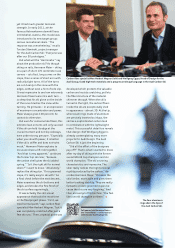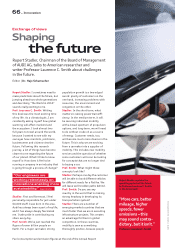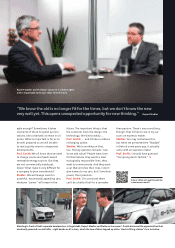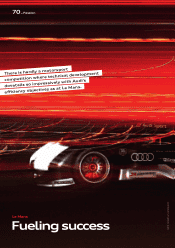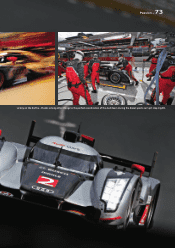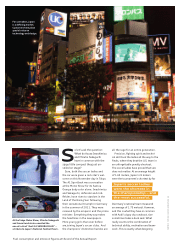Audi 2011 Annual Report Download - page 71
Download and view the complete annual report
Please find page 71 of the 2011 Audi annual report below. You can navigate through the pages in the report by either clicking on the pages listed below, or by using the keyword search tool below to find specific information within the annual report.
68
_ Innovation
PHOTOS | JON ENOCH/EYEVINE/INTERTOPICS; THOMAS DASHUBER/MUNICH; AUDI AG (3)
of battery range available today would
be enough. But I think tomorrow’s
cars will need to have much greater
capabilities: The Internet is going to
bring massive change to our mobility
and our transportation systems.
Stadler: F
or Audi, I have issued the
slogan “Always on.” Connectivity in the
car means that you will be telling your
car where to go via speech recognition,
with your car then fi guring out the
best route and estimated trip time,
optimized thanks to satellite navigation
and online traffi c information.
At the same time, all cars will be
communicating with each other, easing
traffi c fl ow and improving safety.
Prof. Smith:
That would be a dream
come true for me. When I was young,
I always wanted to take the wheel
myself. But what a waste of time and
nerves this constant stop-and-go
is! Today, I would rather rely on an
autopilot.
Stadler: That is the kind of future
scenario that we are developing as part
of the Audi Urban Future Initiative,
drawing in architects, urban planners
and transportation experts. Anyone
who is on the road in Beijing, Mumbai
or Rio will realize the same thing every
day: standing in traffi c means standing
still, and standing still is the opposite
of progress. We have the knowledge,
the resources and the responsibility
to participate in shaping the future.
Prof. Smith: In the USA, just as
elsewhere, the Audi brand stands for
sophisticated, urban, technology-driven.
When do you think we will see the
fi rst self-steering vehicle?
Stadler: We presented our concept of
a driverless TT at the Geneva Motor
Show in 2011. But it’s going to take a
while for people to get used to the idea
that sensors in a car can steer it better
and faster than a human being can.
Prof. Smith: Acceptance is a huge
cultural challenge. Many visions have
taken too long to come into their own.
Stadler: Our customers are curious,
technology-friendly types. They want
to know: How does an electric car
accelerate, how does it handle?
The younger generation, in particular,
is very open. Smartphones have
boosted acceptance of IT incredibly.
If you watch science fi ction movies
from the 1980s, they show things that
were unimaginable at the time, like
tablet PCs or navigation systems –
things that we think are absolutely
normal today.
Prof. Smith: There are dangers in the
future, too. Our problem would be
less the growth of the population and
more increasing prosperity. If all seven
billion citizens of the Earth aspired to
live at U.S. standards, we would soon
be needing resources amounting to the
equivalent of about 72 billion people.
Stadler: Resource effi ciency is the
order of the day. If we can achieve that,
we can raise prosperity and at the same
time contain resource consumption.
Growth will only be sustainable if we
don’t just subscribe to commercial
success, but also to society and the
environment. This is a fi eld in which
we will be investing 13 billion euros
over the next fi ve years alone,
especially in new propulsion technol-
ogy and lightweight materials.
Prof. Smith: More cars, better mileage,
higher speeds, fewer emissions – this
may sound contradictory, but it isn’t.
At the same time, the car industry is
experiencing a countertrend in big
cities: Young people in particular often
don’t want to own a car anymore.
Perhaps they think it’s too expensive,
perhaps it’s because of lack of parking
space, or they may be having doubts in
principle.
Stadler: Though a car may no longer
top the wish list of many young people,
they still have a desire for individual
mobility. If you want to drive, but don’t
want a car in your garage, you can opt
for temporary off ers – a sedan with a
driver, or a quattro for a holiday trip.
Prof. Smith: Your company is going
to need to evolve constantly.
What does this uncertainty mean for
management?
Stadler:
It creates an optimistic
tension. We know the old is no longer
fi t for the times, but we don’t know
the new very well yet. This opens
unexpected opportunities for new
thinking. Who is to provide sustainable
solutions, if not a technology driver
such as Audi? The crucial question is:
Will government and society prove
The futurologist
Professor Laurence C. Smith
Prof. Laurence C. Smith
caused a major
sensation with his book
“The World in 2050.”
“In the USA, the Audi brand
stands for sophisticated,
urban, technology-driven.”
Prof. Laurence C. Smith
“Resource effi ciency
is the order of the day.”
Rupert Stadler
“Our customers are
curious, technology-
friendly types.” Rupert Stadler
Laurence C. Smith, 44,
is a professor of geo-
graphy,
earth sciences
and astrophysics at the
University of Califor-
nia. To write his book
“The World in 2050,”
Smith traveled around
the world for almost
two years to speak to
scientists, politicians
and
entrepreneurs and
to answer important
questions about the
future: How will we
live? What cities will
we be
living in? Which
countries will win,
which will lose? What
will we be leaving
behind for our children?
Smith believes that
four “global forces” will
shape the
world of
tomorrow: demogra-
phics, globalization,
scarcity of resources
and climate change.
Fuel consumption and emission fi gures at the end of the Annual Report



